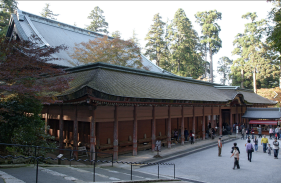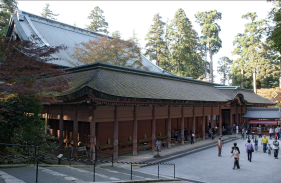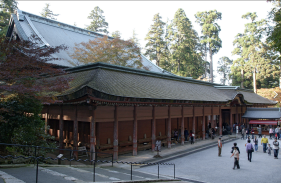
MapCode :
7 526 464*13
Phone :
075-682-0800
Website :
Hours :
Open daily 08:00 – 20:00
Address :
31-1 Higashikujō Kamitonodachō, Minami Ward, Kyoto, 601-8002
14.6
km / 9.1
miles
-
(37
minutes)

MapCode :
7 715 593*25
Phone :
077-529-2216
Website :
Hours :
Open daily 09:00 – 19:00
Address :
776−30 Yamagamicho, Otsu, Shiga 520-0038
6.4
km / 4.0
miles
-
(13
minutes)

MapCode :
7 866 120*52
Phone :
077-578-0001
Website :
Description :
even marched on the capital to enforce monastic demands.
As part of a program to remove all potential rivals and unite the country, warlord Oda Nobunaga ended this Buddhist militancy in 1571 by attacking Enryaku-ji, leveling the buildings and slaughtering monks.
Enryaku-ji's current structures date from the late 16th century through the first half of the 17th century, when the temple was reconstructed following a change of government. Only one minor building survived, the Ruri-dō ("Lapis Lazuli Hall"), which is located down a long, unmarked path from the Sai-tō complex. The structure dates to the 13th century and was repaired twice during the 20th century following harsh weather. During reconstruction, some buildings were transferred from other temples, notably Mii-dera, and thus the buildings themselves are old, though they have not always been at this location.
Today, most of Enryaku-ji's buildings are clustered in three areas: Tō-dō (東塔, "East Pagoda"), Sai-tō (西塔, "West Pagoda"), and Yokokawa (横川). The monastery's most important buildings are concentrated in Tō-dō. Sai-tō is a 20-minute walk away, primarily downhill from Tō-dō, and also features several important buildings. Yokokawa is more isolated and less visited, about a 1:30 walk, and is most easily reached by bus, which connects the three complexes and other locations on the mountain.
To-do includes the Konpon Chu-do (a national treasure), the Kaidan-in (important cultural asset), the Hokke So Ji-in, Amida-do (training hall), the Dai Ko-do (important cultural asset), and the Kokuho-den (national treasure storage building).
Courtesy of Wikipedia
As part of a program to remove all potential rivals and unite the country, warlord Oda Nobunaga ended this Buddhist militancy in 1571 by attacking Enryaku-ji, leveling the buildings and slaughtering monks.
Enryaku-ji's current structures date from the late 16th century through the first half of the 17th century, when the temple was reconstructed following a change of government. Only one minor building survived, the Ruri-dō ("Lapis Lazuli Hall"), which is located down a long, unmarked path from the Sai-tō complex. The structure dates to the 13th century and was repaired twice during the 20th century following harsh weather. During reconstruction, some buildings were transferred from other temples, notably Mii-dera, and thus the buildings themselves are old, though they have not always been at this location.
Today, most of Enryaku-ji's buildings are clustered in three areas: Tō-dō (東塔, "East Pagoda"), Sai-tō (西塔, "West Pagoda"), and Yokokawa (横川). The monastery's most important buildings are concentrated in Tō-dō. Sai-tō is a 20-minute walk away, primarily downhill from Tō-dō, and also features several important buildings. Yokokawa is more isolated and less visited, about a 1:30 walk, and is most easily reached by bus, which connects the three complexes and other locations on the mountain.
To-do includes the Konpon Chu-do (a national treasure), the Kaidan-in (important cultural asset), the Hokke So Ji-in, Amida-do (training hall), the Dai Ko-do (important cultural asset), and the Kokuho-den (national treasure storage building).
Courtesy of Wikipedia
Hours :
Open daily 08:30 - 16:30
Address :
4220 Sakamotohonmachi, Otsu, Shiga 520-0116
0.9
km / 0.6
miles
-
(2
minutes)

MapCode :
7 865 189*21
Phone :
077-578-0001
Website :
Description :
Enryaku-ji is a Tendai monastery located on Mount Hiei in Ōtsu, in Shiga Prefecture, overlooking Kyoto. It was first founded in 788 during the early Heian period (794–1185) by Saichō (767–822), also known as Dengyō Daishi, who introduced the Tendai sect of Mahayana Buddhism to Japan from China. The temple complex has undergone several reconstruction efforts since then, with the most significant (that of the main hall) taking place in 1642 under Tokugawa Iemitsu.
Enryaku-ji is the headquarters of the Tendai sect and one of the most significant monasteries in Japanese history. As such, it is part of the UNESCO World Heritage Site "Historic Monuments of Ancient Kyoto (Kyoto, Uji and Otsu Cities)". The founders of Jōdo-shū, Jōdo Shinshū, Sōtō Zen, and Nichiren Buddhism all spent time at the monastery. Enryaku-ji is also the center for the practice of kaihōgyō (aka the "marathon monks").
With the support of Emperor Kanmu, the Buddhist monk Saichō ordained a hundred disciples in 807. Maintaining a strict discipline on Mt. Hiei, his monks lived in seclusion for twelve years of study and meditation. After this period, the best students were retained in positions in the monastery and others graduated into positions in the government. At the peak of its power, Enryaku-ji was a huge complex of as many as 3,000 sub-temples and a powerful army of warrior monks (sōhei).
In the tenth century, succession disputes broke out between Tendai monks of the line of Ennin and Enchin. These disputes resulted in opposing Tendai centers at Enryaku-ji and at Mii-dera, known respectively as the Mountain Order (sanmon) and the Temple Order ( jimon). Warrior monks were used to settle the disputes, and Tendai leaders began to hire mercenary armies who threatened rivals and even marched on the capital to enforce monastic demands.
As part of a program to remove all potential rivals and unite the country, warlord Oda Nobunaga ended this Buddhist militancy in 1571 by attacking Enryaku-ji, leveling the buildings and slaughtering monks.
Enryaku-ji's current structures date from the late 16th century through the first half of the 17th century, when the temple was reconstructed following a change of government. Only one minor building survived, the Ruri-dō ("Lapis Lazuli Hall"), which is located down a long, unmarked path from the Sai-tō complex. The structure dates to the 13th century and was repaired twice during the 20th century following harsh weather. During reconstruction, some buildings were transferred from other temples, notably Mii-dera, and thus the buildings themselves are old, though they have not always been at this location.
Today, most of Enryaku-ji's buildings are clustered in three areas: Tō-dō (東塔, "East Pagoda"), Sai-tō (西塔, "West Pagoda"), and Yokokawa (横川). The monastery's most important buildings are concentrated in Tō-dō. Sai-tō is a 20-minute walk away, primarily downhill from Tō-dō, and also features several important buildings. Yokokawa is more isolated and less visited, about a 1:30 walk, and is most easily reached by bus, which connects the three complexes and other locations on the mountain.
Sai-to includes Shaka-do (important cultural asset), Ninai-do (important cultural asset), Ruri-do (important cultural asset), Jodo-in (mausoleum of Dengyo Daishi), and Tsubaki-do.
Courtesy of Wikipedia
Enryaku-ji is the headquarters of the Tendai sect and one of the most significant monasteries in Japanese history. As such, it is part of the UNESCO World Heritage Site "Historic Monuments of Ancient Kyoto (Kyoto, Uji and Otsu Cities)". The founders of Jōdo-shū, Jōdo Shinshū, Sōtō Zen, and Nichiren Buddhism all spent time at the monastery. Enryaku-ji is also the center for the practice of kaihōgyō (aka the "marathon monks").
With the support of Emperor Kanmu, the Buddhist monk Saichō ordained a hundred disciples in 807. Maintaining a strict discipline on Mt. Hiei, his monks lived in seclusion for twelve years of study and meditation. After this period, the best students were retained in positions in the monastery and others graduated into positions in the government. At the peak of its power, Enryaku-ji was a huge complex of as many as 3,000 sub-temples and a powerful army of warrior monks (sōhei).
In the tenth century, succession disputes broke out between Tendai monks of the line of Ennin and Enchin. These disputes resulted in opposing Tendai centers at Enryaku-ji and at Mii-dera, known respectively as the Mountain Order (sanmon) and the Temple Order ( jimon). Warrior monks were used to settle the disputes, and Tendai leaders began to hire mercenary armies who threatened rivals and even marched on the capital to enforce monastic demands.
As part of a program to remove all potential rivals and unite the country, warlord Oda Nobunaga ended this Buddhist militancy in 1571 by attacking Enryaku-ji, leveling the buildings and slaughtering monks.
Enryaku-ji's current structures date from the late 16th century through the first half of the 17th century, when the temple was reconstructed following a change of government. Only one minor building survived, the Ruri-dō ("Lapis Lazuli Hall"), which is located down a long, unmarked path from the Sai-tō complex. The structure dates to the 13th century and was repaired twice during the 20th century following harsh weather. During reconstruction, some buildings were transferred from other temples, notably Mii-dera, and thus the buildings themselves are old, though they have not always been at this location.
Today, most of Enryaku-ji's buildings are clustered in three areas: Tō-dō (東塔, "East Pagoda"), Sai-tō (西塔, "West Pagoda"), and Yokokawa (横川). The monastery's most important buildings are concentrated in Tō-dō. Sai-tō is a 20-minute walk away, primarily downhill from Tō-dō, and also features several important buildings. Yokokawa is more isolated and less visited, about a 1:30 walk, and is most easily reached by bus, which connects the three complexes and other locations on the mountain.
Sai-to includes Shaka-do (important cultural asset), Ninai-do (important cultural asset), Ruri-do (important cultural asset), Jodo-in (mausoleum of Dengyo Daishi), and Tsubaki-do.
Courtesy of Wikipedia
Hours :
Open daily 09:00 - 16:00
Address :
4220 Sakamotohon-machi, Otsu, Shiga 520-0116
4.3
km / 2.7
miles
-
(7
minutes)

MapCode :
479 056 087*54
Phone :
077-578-0001
Website :
Description :
Enryaku-ji is a Tendai monastery located on Mount Hiei in Ōtsu, in Shiga Prefecture, overlooking Kyoto. It was first founded in 788 during the early Heian period (794–1185) by Saichō (767–822), also known as Dengyō Daishi, who introduced the Tendai sect of Mahayana Buddhism to Japan from China. The temple complex has undergone several reconstruction efforts since then, with the most significant (that of the main hall) taking place in 1642 under Tokugawa Iemitsu.
Enryaku-ji is the headquarters of the Tendai sect and one of the most significant monasteries in Japanese history. As such, it is part of the UNESCO World Heritage Site "Historic Monuments of Ancient Kyoto (Kyoto, Uji and Otsu Cities)". The founders of Jōdo-shū, Jōdo Shinshū, Sōtō Zen, and Nichiren Buddhism all spent time at the monastery. Enryaku-ji is also the center for the practice of kaihōgyō (aka the "marathon monks").
With the support of Emperor Kanmu, the Buddhist monk Saichō ordained a hundred disciples in 807. Maintaining a strict discipline on Mt. Hiei, his monks lived in seclusion for twelve years of study and meditation. After this period, the best students were retained in positions in the monastery and others graduated into positions in the government. At the peak of its power, Enryaku-ji was a huge complex of as many as 3,000 sub-temples and a powerful army of warrior monks (sōhei).
In the tenth century, succession disputes broke out between Tendai monks of the line of Ennin and Enchin. These disputes resulted in opposing Tendai centers at Enryaku-ji and at Mii-dera, known respectively as the Mountain Order (sanmon) and the Temple Order ( jimon). Warrior monks were used to settle the disputes, and Tendai leaders began to hire mercenary armies who threatened rivals and even marched on the capital to enforce monastic demands.
As part of a program to remove all potential rivals and unite the country, warlord Oda Nobunaga ended this Buddhist militancy in 1571 by attacking Enryaku-ji, leveling the buildings and slaughtering monks.
Enryaku-ji's current structures date from the late 16th century through the first half of the 17th century, when the temple was reconstructed following a change of government. Only one minor building survived, the Ruri-dō ("Lapis Lazuli Hall"), which is located down a long, unmarked path from the Sai-tō complex. The structure dates to the 13th century and was repaired twice during the 20th century following harsh weather. During reconstruction, some buildings were transferred from other temples, notably Mii-dera, and thus the buildings themselves are old, though they have not always been at this location.
Today, most of Enryaku-ji's buildings are clustered in three areas: Tō-dō (東塔, "East Pagoda"), Sai-tō (西塔, "West Pagoda"), and Yokokawa (横川). The monastery's most important buildings are concentrated in Tō-dō. Sai-tō is a 20-minute walk away, primarily downhill from Tō-dō, and also features several important buildings. Yokokawa is more isolated and less visited, about a 1:30 walk, and is most easily reached by bus, which connects the three complexes and other locations on the mountain.
Yokawa includes the Yokawa Chu-do, the Eshin-do, the Konpon Nyoho-to, the Joko-in, and the Shiki Ko-do (Gansan Daishi-do).
Courtesy of Wikipedia
Enryaku-ji is the headquarters of the Tendai sect and one of the most significant monasteries in Japanese history. As such, it is part of the UNESCO World Heritage Site "Historic Monuments of Ancient Kyoto (Kyoto, Uji and Otsu Cities)". The founders of Jōdo-shū, Jōdo Shinshū, Sōtō Zen, and Nichiren Buddhism all spent time at the monastery. Enryaku-ji is also the center for the practice of kaihōgyō (aka the "marathon monks").
With the support of Emperor Kanmu, the Buddhist monk Saichō ordained a hundred disciples in 807. Maintaining a strict discipline on Mt. Hiei, his monks lived in seclusion for twelve years of study and meditation. After this period, the best students were retained in positions in the monastery and others graduated into positions in the government. At the peak of its power, Enryaku-ji was a huge complex of as many as 3,000 sub-temples and a powerful army of warrior monks (sōhei).
In the tenth century, succession disputes broke out between Tendai monks of the line of Ennin and Enchin. These disputes resulted in opposing Tendai centers at Enryaku-ji and at Mii-dera, known respectively as the Mountain Order (sanmon) and the Temple Order ( jimon). Warrior monks were used to settle the disputes, and Tendai leaders began to hire mercenary armies who threatened rivals and even marched on the capital to enforce monastic demands.
As part of a program to remove all potential rivals and unite the country, warlord Oda Nobunaga ended this Buddhist militancy in 1571 by attacking Enryaku-ji, leveling the buildings and slaughtering monks.
Enryaku-ji's current structures date from the late 16th century through the first half of the 17th century, when the temple was reconstructed following a change of government. Only one minor building survived, the Ruri-dō ("Lapis Lazuli Hall"), which is located down a long, unmarked path from the Sai-tō complex. The structure dates to the 13th century and was repaired twice during the 20th century following harsh weather. During reconstruction, some buildings were transferred from other temples, notably Mii-dera, and thus the buildings themselves are old, though they have not always been at this location.
Today, most of Enryaku-ji's buildings are clustered in three areas: Tō-dō (東塔, "East Pagoda"), Sai-tō (西塔, "West Pagoda"), and Yokokawa (横川). The monastery's most important buildings are concentrated in Tō-dō. Sai-tō is a 20-minute walk away, primarily downhill from Tō-dō, and also features several important buildings. Yokokawa is more isolated and less visited, about a 1:30 walk, and is most easily reached by bus, which connects the three complexes and other locations on the mountain.
Yokawa includes the Yokawa Chu-do, the Eshin-do, the Konpon Nyoho-to, the Joko-in, and the Shiki Ko-do (Gansan Daishi-do).
Courtesy of Wikipedia
Hours :
Open daily 09:00 - 16:00
Address :
Sakamotohonmachi, Otsu, Shiga 520-0116
1.7
km / 1.0
miles
-
(3
minutes)

MapCode :
479 058 814*72
Phone :
077-578-2139
Website :
Hours :
Open daily 09:00M – 19:00
Address :
Sakamotohonmachi, Otsu, Shiga 520-0116, Japan
5.2
km / 3.2
miles
-
(10
minutes)

MapCode :
479 089 444*53
Phone :
077-572-1268
Website :
Hours :
Open daily 09:00 – 19:00
Address :
2-27-55 Ōgi, Otsu, Shiga 520-0247, Japan
14.1
km / 8.8
miles
-
(20
minutes)

MapCode :
7 658 037*28
Phone :
077-522-3830
Hours :
Open daily 24/7
Address :
7 Miideracho, Otsu, Shiga 520-0034
14.4
km / 9.0
miles
-
(32
minutes)

MapCode :
7 526 641*30
Address :
Higashishiokoji Kamadonocho, Shimogyo Ward, Kyoto, 600-8216